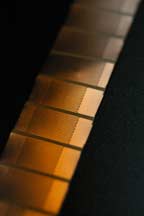Researchers at the University of Michigan have focused microwaves to specks 20 times smaller than their wavelength and five times smaller than other devices have achieved.
This development could allow advances such as laptop computers that recharge without plugging in, higher-resolution microscopes for observing molecules, and CDs that can store vastly more data.
A paper on the research will be published in the April 25 edition of Science. Authors include Anthony Grbic, assistant professor of electrical engineering and computer science; Roberto Merlin, professor of physics as well as electrical engineering and computer science; and Lei Jiang, a graduate student in physics. The work is an experimental realization of a concept and device proposed earlier in two theoretical papers.
"This is the highest resolution to date achieved at microwave frequencies," Grbic said. "It opens up a whole range of applications, including wireless power transfer, microscopy and beam-shaping devices to focus the radiation. If we can push this to light frequencies, and there are no reasons why this couldn't be done, it will have applications in lithography and data storage."
Microwaves have a lower frequency and longer wavelength than visible light. Lithography is used in etching integrated circuits for computer processors and memory.
Focusing light waves and other electromagnetic radiation to points smaller than their wavelength was long thought to be impossible. But by manipulating these waves before they get too far away from their source, scientists and engineers in recent years have been able to break this so-called diffraction limit.
Grbic and his colleagues focused 30-cm microwaves at 1GHz frequency to points approximately 1.5 cm in size.
They achieved this by aiming the radiation through specially patterned, slotted panels placed within the source's electromagnetic near field. The electromagnetic near field is the region around an antenna or radiation source within one wavelength of the emitted radiation. In this case, the near field was within 30 cm of the source.
The slotted panels, called near-field plates, work as alternatives to lenses. Other methods of focusing beneath the diffraction limit use metamaterials, which are special man-made, three-dimensional lenses that are relatively expensive to produce.
The plates that Grbic, Merlin and Jiang produced are made by single-layer processing. They are easier to make and less expensive than metamaterials, they say.
"A big advantage of our approach is that the underlying focusing concept can be applied to a wide range of operating frequencies," Merlin said. "Much as the well-known Fresnel zone plates can be used for conventional (diffraction-limited) focusing of microwaves and X-rays, the near-field plates can do the same with super resolution."
Their study is called "Near-Field Plates: Subdiffraction Focusing with Patterned Surfaces."

